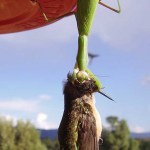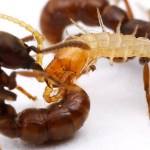predation
Giant insects can eat tiny dinosaurs.
In this case, the giant insects are praying mantis, and the dinosaurs are hummingbirds and other small birds. In some cases, maybe most cases, this involves small birds like hummingbirds being taken at nectar sites (natural or otherwise) by introduced species of praying mantis in the US.
Here's the info from the recently published paper:
Bird Predation By Praying Mantises: A Global Perspective, by Martin Nyffeler, Michael R. Maxwell, and J. V. Remsen, Jr.
ABSTRACT
We review 147 incidents of the capture of small birds by mantids (order Mantodea, family…
Late Wednesday evening, a terrible disaster began to unfold in the ScienceBlogs universe: word emerged that a zombie attack was taking place in our bloggers' homes. While the attack was believed to have begun somewhere in the southeastern United States, with patient zero Scicurious, it has now spread across the continent and even as far as Martin Rundkvist in Sweden. But even while in pursuit of human brains, the zombies are still dedicated to the mission of communicating science—in this case, getting the word out about the real science of zombiekind. To read up on how zombie epidemics spread…
A leopard (Panthera pardus). Image from Wikipedia.
SK-54 is a curious fossil. The 1.5 million year old skullcap represents a juvenile Paranthropus robustus, one of the heavy-jawed hominins which lived in prehistoric South Africa, but there is something that makes this skull fragment particularly special. Near one of the sutures along the back of the skull are two neat puncture marks, the hallmark of a leopard.
Even though it was initially proposed that SK-54 had been murdered by another australopithecine wielding a weapon of bone or horn, in the late 1960's the paleontologist C.K. Brain…
tags: Praying Mantis, Preying Mantis, mantid, insects, birds, hummingbirds, offbeat, predation, predatory behavior, nature, streaming video
Sandy Lizotte, the Ventura Hummingbird Lady, captures a rare and remarkable moment where a praying mantis was waiting patiently at a hummingbird feeder to ambush a hummingbird. As you'll see in this video, the mantid succeeds.
The hummingbird did survive.
A jaguar (Panthera onca). From Flickr user Prosper 973.
One year ago this week Macho B was euthanized. He had been captured in mid-February of 2009, the only known jaguar living inside the United States, but after he was caught and fitted with a radio collar his health quickly deteriorated. When he nearly stopped moving he was recaptured, taken to the Phoenix zoo, and put to sleep when it was discovered that he was suffering from irreparable kidney failure.
At first it seemed as if his capture was a lucky accident, but a later investigation by the Fish and Wildlife Service found that the…
On Laelaps, Brian Switek tells the story of a man who cooled off in an Ethiopian river against all advice, only to meet his death. Brian writes that "like our hominin forebears we can still be prey, and crocodiles are among the animals that have long considered us to be on the menu." Crocs were munching on our ancestors long before the pyramids rose along the Nile, and scientists have even named one ancient monstrosity Anthropophagus, the man-eater. Still, evidence for predation is slim, possibly because hominins who "fell prey to fully-grown crocodiles" were metabolized without a trace…
Photographed this weekend in Dixon Springs, Illinois:
These Aphaenogaster lamellidens foragers have discovered a live centipede and are attempting to pull it from its burrow.
photo details: Canon mp-e 65mm 1-5x macro lens on a Canon EOS 50D
ISO 100, f/11-f/13, 1/250 sec, flash diffused through tracing paper
An ant, climbing from the pit of a predatory ant lion.
The predator, buried in sand at the base of the pit, hurls a volley of debris towards its target.
Caught in the falling sand, the ant slides back into the pit.
The ant tries to escape, and again the unseen predator hurls a load of sand into her path.
No matter which way the ant turns, the ant lion adjusts its aim, sending up clouds of sand and preventing the ant from gaining traction on the steep walls of the pit.
In the end, the ant lion wins.
A tight crop of the previous image shows the jaws of the ant lion reaching up…
An Amblyopone oregonensis huntress delivers a paralyzing dose of venom to a centipede. This lets the ant larvae consume it alive later, at their leisure. Ow. Ow, Ow. Yes, that is the stinger you see, sunk deep into the head.
A cricket is impaled on the mandibles of a Malagasy trap-jaw ant, Odontomachus coquereli. That's gotta hurt.
Mantids don't wait for their prey to expire before they tear them to pieces.
An aphid receives the egg of a braconid wasp (Aphidius ervi).
But that's probably better than getting your innards suddenly schlorped out by a syrphid fly larva.
From the BBC's excellent, if overly dramatic, wildlife unit:
Widow spider and harvester ants. Hallelujah Junction, California
This young black widow (Latrodectus hesperus) set up shop above the nest entrance of a colony of Pogonomyrmex harvester ants. It's an all-you-can-eat buffet, allowing the spider nearly unlimited pickings as the ants come and go.
The spider's mottled coloration is typical of young widows; they don't acquire the striking black and red warning garb until maturity.
photo details: Canon 100mm f2.8 macro lens on a Canon EOS D60
ISO 100, 1/200 sec, f/11, MT-24EX twin flash
Take that, vertebrate scum!
Incidentally, my wife used to have one of these Nephila spiders nesting in the high ceiling of her living room when she was living in Queensland. I guess she used it to dissuade potential suitors, but somehow I made it through.
A perpetually happy Venezuelan Leptogenys
We don't really know why some species of Leptogenys hunting ants sport a permanent grin. The oddly ecstatic mandible shape might, however, have something to do with handling the broadly curved exoskeleton of their preferred prey: isopods (the sow bugs and pill bugs).
Flickr user "venwu225" recently uploaded a fantastic series of the related species L. falcigera in action. Some of the shots show how the mandibles allow the ant to grip the isopod both above and below its wide skirt of armor. Cool stuff.
photo details: Canon MP-E 65mm 1-5x macro…
I can't imagine a more unpleasant way to go. This poor oleander aphid (Aphis nerii) has its innards sucked out by a hoverfly larva.
photo details: Canon MP-E 65mm 1-5x macro lens on a Canon 20D
f/13, 1/250 sec, ISO 100
MT-24EX flash diffused through tracing paper
levels adjusted in Photoshop.

